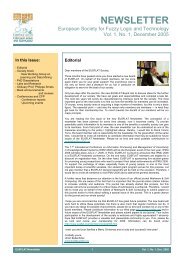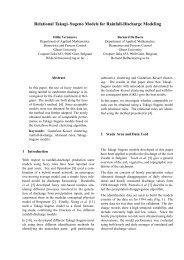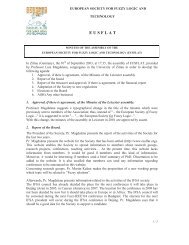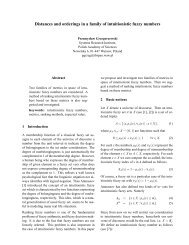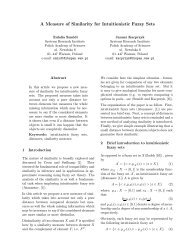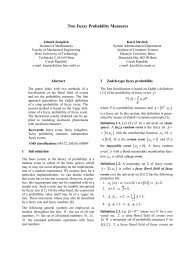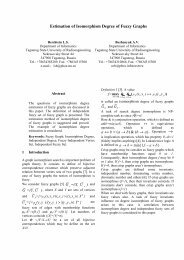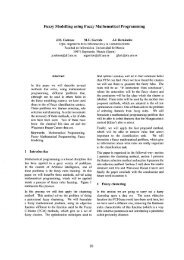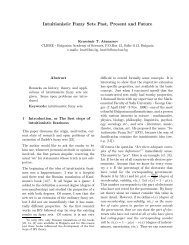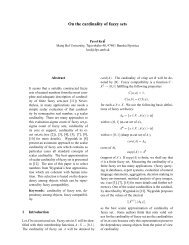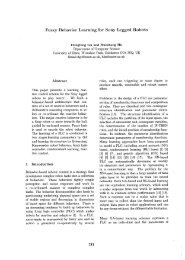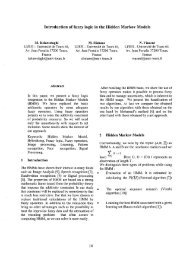KM-Fuzzy Approach Space - EUSFLAT
KM-Fuzzy Approach Space - EUSFLAT
KM-Fuzzy Approach Space - EUSFLAT
Create successful ePaper yourself
Turn your PDF publications into a flip-book with our unique Google optimized e-Paper software.
Proof.<br />
1. Since A ⊆ A, by 3 of lemma 4.2, F (x,A,t) ≤ F x,A,t .<br />
Using axiom FA5 with r = 0, it holds<br />
F (x,A,t + s) ≥ F(x,A (0) ,t)=F(x,A,t)<br />
for s > 0.<br />
Taking infimum on s, wehaveF (x,A,t) ≥ F(x,A,t).<br />
2. By 6 of lemma 4.2, A ⊆ A. Let x ∈ A = A (0)(0) . This is<br />
equivalent to <br />
F x,A (0) <br />
,t = 1<br />
for all t > 0. Using axiom FA5 with r = 0,<br />
F (x,A,t + s) ≥ F(x,A (0) ,t)=1<br />
for t,s > 0. Then x ∈ A (0) = A.<br />
3. Trivial.<br />
<br />
4. Let x ∈ X be such that F x,A (r) <br />
,t = 1 for all t > 0. By<br />
FA5,<br />
<br />
F (x,A,t + s) ≥ F x,A (r) <br />
,t = 1<br />
for all t > 0, s > r ≥ 0. In particular x ∈ A (r) . The previous<br />
property implies that A (r) is closed.<br />
5. Trivial.<br />
6. Let r,s ≥ 0 and x ∈ (A (r) ) (s) , that is,<br />
<br />
F x,A (r) <br />
,t = 1<br />
for all t > s. By FA5,<br />
F (x,A,t + s) ≥ F<br />
<br />
x,A (r) <br />
,t = 1<br />
for t > s > r ≥ 0. Thus x ∈ A (r+s) .<br />
The following proposition is an interesting property related<br />
to closures of subsets of FA-spaces.<br />
Proposition 4.4 Let (X,F) be a FA-space, r ≥ 0 and A,B ⊆ X<br />
subsets of X.<br />
1. A (r) ∪ B (r) ⊆ (A ∪ B) (r) .<br />
2. If (X,F) verifies the equality in FA4, then (A ∪ B) (r) =<br />
A (r) ∪ B (r) .<br />
Proof. Since A ⊆ A ∪ B and B ⊆ A ∪ B, by 5 in lemma 4.2,<br />
A (s) ⊆ (A ∪ B) (s) , B (s) ⊆ (A ∪ B) (s) .<br />
Then A (s) ∪ B (s) ⊆ (A ∪ B) (s) .<br />
Suppose that the equality holds in FA4. If x ∈ (A ∪ B) (r) ,<br />
then<br />
Max(F (x,A,t),F (x,B,t)) = F (x,A ∪ B,t)=1,<br />
for all t > r.<br />
Then, for each t > r,<br />
F (x,A,t)=1orF (x,B,t)=1.<br />
Suppose that t > r is such that F (x,A,t)=1. If s > 0, then<br />
F(x,A,t + s)=F(x,A (r) ,t) ≥ F(x,A,t)=1.<br />
Then F(x,A,t)=1 for all t > r; i.e., x ∈ A (r) .<br />
Consequently, x ∈ A (r) or x ∈ B (r) and then x ∈ A (r) ∪ B (r) .<br />
ISBN: 978-989-95079-6-8<br />
IFSA-<strong>EUSFLAT</strong> 2009<br />
References<br />
[1] Lotfi A. Zadeh. <strong>Fuzzy</strong> sets. Information and Control, 8:338–353,<br />
1965.<br />
[2] A. George and P. Veeramani. On some results in fuzzy metric<br />
spaces. <strong>Fuzzy</strong> Sets Syst, 64:395–399, 1994.<br />
[3] O. Kaleva and S. Seikkala. On fuzzy metric spaces. <strong>Fuzzy</strong> Sets<br />
Syst, 12:215–229, 1984.<br />
[4] D. Mihet. A banach contraction theorem in fuzzy metric spaces.<br />
<strong>Fuzzy</strong> Sets Syst, 144:431–439, 2004.<br />
[5] I. Kramosil and J. Michalek. <strong>Fuzzy</strong> metrics and statistical metric<br />
spaces. Kybernetika, 11:336–344, 1975.<br />
[6] R. Lowen. <strong>Approach</strong> spaces. The missing link in the topologyuniformity-metric<br />
triad. Oxford Mathematical Monographs. Oxford<br />
University Press, 1997.<br />
[7] D. Vaughan R. Lowen, M. Sioen. Completing quasi-metric<br />
spaces - an alternative approach. Houston J. Math., 29:113–136,<br />
2003.<br />
1705



